Estonian kroon
| Crown | |
|---|---|
| Country: |
|
| Subdivision: | 100 senti |
| ISO 4217 code : | EEK |
| Abbreviation: | kr, EEK |
|
Exchange rate : (fixed) |
1 EUR = 15.6466 EEK |
The Estonian kroon ( Estonian : Eesti kroon ) was the currency of Estonia from 1928 to 1940 and from 1992 to 2010 . It was issued by the Estonian Central Bank ( Eesti Pank ). The Estonian kroon was = 8 EEK to the to 2001 in the ratio 1 DM Deutschmark coupled, since 2002 in the ratio 1 EUR = 15.6466 EEK to the euro . There were banknotes of 1, 2, 5, 10, 25, 50, 100, 500 kroner and coins of 5, 10, 20 and 50 senti as well as 1 and 5 kroner.
On January 1, 1928, the Estonian kroon replaced the Estonian mark as the currency of Estonia. After the annexation of Estonia by the Soviet Union in 1940, the Estonian kroon was exchanged at the rate of 1 (Soviet) ruble = 0.80 kroner. After regaining independence, the Estonian kroon was reintroduced in 1992 at the rate of 1 kroon = 10 (Russian) rubles .
On January 1, 2011, it was replaced by the euro when Estonia joined the European Monetary Union.
Banknotes
| Face value | image | front | back | expenditure | |
|---|---|---|---|---|---|
| 1 kroon |
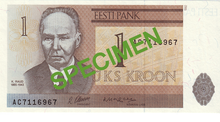
|

|
Kristjan Raud (painter, graphic artist) | Toompea loss (castle on the Cathedral Hill ) in Tallinn | 1992 |
| 2 krooni |
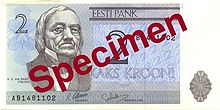
|

|
Karl Ernst von Baer (anthropologist, naturalist, geographer) | University of Tartu | 1992, 2006, 2007 |
| 5 Krooni |

|
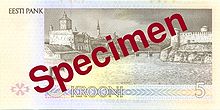
|
Paul Keres (chess player) | Hermann's Fortress of Narva (Keres birthplace), Narva River and Ivangorod Fortress (Russia) | 1991, 1992, 1994 |
| 10 krooni |

|
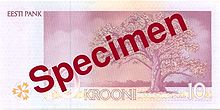
|
Jakob Hurt (folklorist, theologian, linguist) | Tamme Lauri oak in Urvaste, South Estonia | 1991, 1992, 1994, 2006, 2007 |
| 25 Krooni |

|

|
Anton Hansen Tammsaare (writer) | Vargamäe (from the work Tõde ja õigus by Anton Hansen Tammsaare) | |
| 50 krooni |

|

|
Rudolf Tobias (composer) | Estonia Theater (National Opera and Concert Hall) | 1994 |
| 100 krooni |

|

|
Lydia Koidula (poet) | North Estonian cliffs | 1991, 1992, 1994, new security features: 1999, 2007 |
| 500 krooni |
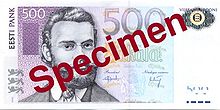
|

|
Carl Robert Jakobson (publicist, writer, educator) | Barn swallow (Estonian national bird ) over the Estonian countryside | 1991, 1994, 1996, new security features: 2000, 2007 |
Coins
1928-1940
1992-2010
| Face value | image | material | Weight | diameter | edge | expenditure | |
|---|---|---|---|---|---|---|---|
| 5 Senti | 93% Cu , 5% Al , 2% Ni , | 1.29 g | 15.95 mm | smooth | 1991, 1992, 1995 | ||
| 10 Senti | 93% Cu, 5% Al, 2% Ni, | 1.87 g | 17.20 mm | smooth | 1991, 1992, 1994, 1996, 1997, 1998, 2002, 2006, 2008 | ||
| 20 Senti | 93% Cu, 5% Al, 2% Ni, | 2.27 g | 18.95 mm | smooth | 1992, 1996 | ||
| 2.27 g | 18.95 mm | smooth | 1997, 1999, 2003, 2004, 2006, 2008 | ||||
| 50 senti | 93% Cu, 5% Al, 2% Ni, | 3 g | 19.50 mm | smooth | 1992, 2004, 2006, 2007 | ||
| 1 kroon | 1992, 1993, 1995 | ||||||
| 89% Cu, 5% Al, 5% Sn 2% Ni, | 5 g | 23.25 mm | 1998, 2000, 2001, 2003, 2006 | ||||
| 89% Cu, 5% Al, 5% Sn 2% Ni, | 5 g | 23.25 mm | 2008 | ||||
| 5 Krooni | 89% Cu, 5% Al, 5% Sn 2% Ni, | 7.1 g | 26.20 mm | 1993 | |||
| 89% Cu, 5% Al, 5% Sn 2% Ni, | 7.1 g | 26.20 mm | 1994 | ||||
Special coins
In addition to the course coins , there were also various special coins . In 2010, three special coins were issued: One with the value of 25 kroner (silver), one with the value of 50 kroner (silver) and the third with the value of 100 kroner (gold). Also in 2008 there was a 100 crown platinum coin:
- 100 crowns (platinum)
Changeover to the euro
Estonia joined the EU on May 1, 2004 . On June 27, 2004, Lithuania and Slovenia joined the Exchange Rate Mechanism II . The initially planned accession at the beginning of 2007 had to be postponed due to the excessive inflation. The euro was introduced on January 1, 2011. The krona was used as currency alongside the euro until January 15, 2011.
See also
Web links
- Central Bank of Estonia: Estonian Coins (Crowns) - Illustrations and Numismatic Notes (page in English)
- Estonian Central Bank: Estonian banknotes (kroner) - illustrations and explanations of the depicted personalities and motifs (page in English)
- The banknotes of Estonia
